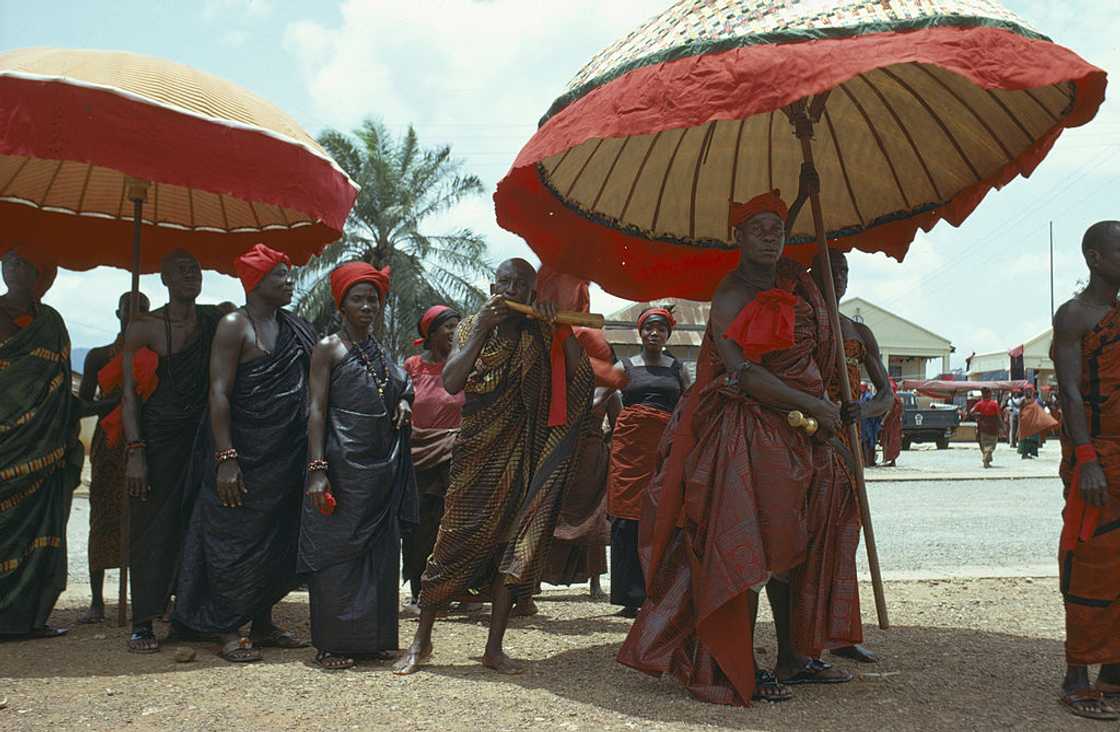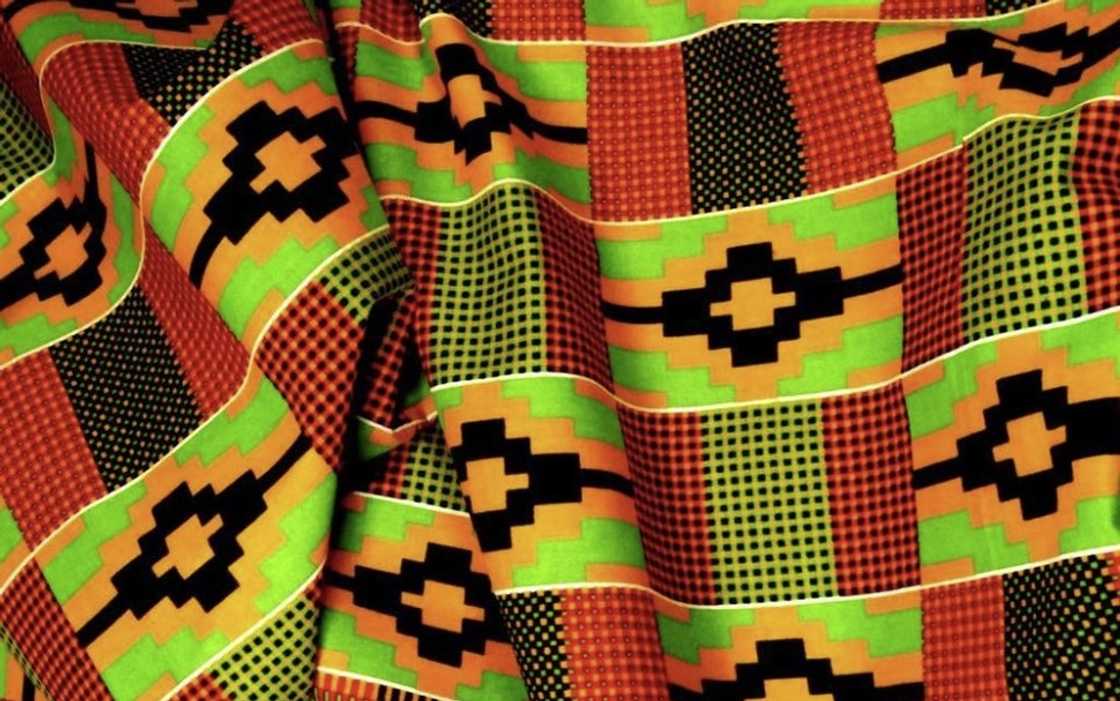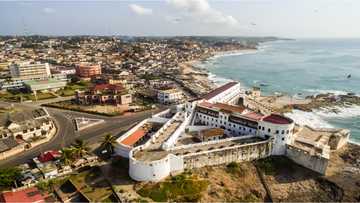Ashanti culture, language, religion, food, rites, clothing, facts
The Ashanti culture is the cultural practices, beliefs, and customs of the Ashanti people of modern Ghana. It is a culture that forms an identifiable part of the Ghanaian culture. The Ashanti tribe, found in central Ghana, is the largest ethnic group of the Akan. They speak the Twi or Akan Kasa language, which carries the prestige of being the first dialect used in Bible translation. In Ghana, the Twi language has over 17 million speakers.

Source: UGC
In the 13th century, the Akan ethnic group migrated to West Africa from the north and settled in the rainforest areas. The ethnic group consisted of small communities in search of fortune and fertile soil.
Their efforts led them to find land with lots of gold. That is one of the reasons historians refer to Ghana as the land of gold. It is also another reason the Ghanaian flag has a yellow/gold colour to showcase the country’s mineral wealth. The Ashanti culture is well known worldwide due to their traditional clothing, food, and rich history.
What is Ashanti?
The Ashanti are people that live in central Ghana known for their metal and gold crafts, woodcarving, and brightly coloured woven clothes. They are the largest tribe in the country.
Traditionally, they have a form of leadership, whereby the Elders and a Chief maintain the group’s traditional ceremonies and customs and also deal with emerging disputes. Although many of them settled in Ghana, you can also find many of them in Ivory Coast and Togo.
Ashanti oral traditions
The Ashanti pass down their cultural beliefs, traditions, and historical narrations of actual events by word of mouth. One of its oral histories states that between the 12th and 13th centuries, they had lots of gold in the areas in which they had settled.
READ ALSO: Ga-Adangbe tribe: language, traditional wear, dances, food, and religion
The gold brought wealth to the Akans. They then decided to migrate outwards and create various states based on mining and trading gold for food and other items. It is this movement that led to the Akan empire or Asante Empire, which lasted between the 1700s and 1900s.
Another oral tradition suggests that Chief Priest Komfo Anokye founded the Ashanti Kingdom after the Golden Stool miraculously descended from the sky and landed on the knees of Nana Osei Tutu. That is how Asantehene Osei Tutu I became the king of all the chiefdoms after conquering them.
Ashanti beliefs

Source: Getty Images
Ashanti oral tradition and spiritual values build on the feelings of profound respect for the land, traditions, and culture. The Ashanti religion, for example, combines supernatural and spiritual powers. As part of the Akan ethnic group, they believe that everything has a soul, especially animals, trees, and other plants.
They also believe in supernatural beings and other magical powers, including witches, forest monsters, and fairies. Although the Ashanti of today has converted to Muslim and Christian denominations, the people believed in the traditional religion that paid respect to ancestors, higher gods, spirits, and supreme beings.
READ ALSO: Positive and negative cultural practices in Ghana
The Ashanti practice many ceremonies. Some of these include birth, puberty, marriage, good harvests, and death. One of the oral traditions regarding the beliefs of the Ashanti is about the significance of the stool. Generally, it is customary for any lineage to have a stool. That is because it serves, among other things, as the symbol of authority.
Also, when children start crawling, their parents give them the stool as a gift. When young women reach puberty, they must sit on the stool, as per the dictates of the puberty rites. During a marriage ceremony, husbands present to their wives the stool.
At death, the elders bath the deceased on a ceremonial stool before burial. The stool is so significant to the beliefs and cultural practices of the Ashanti because it illustrates its ability to represent the soul of a person.
Is it Asante or Ashanti?
Asante and Ashanti are two terms used interchangeably. Both names refer to the people of south-central Ghana that live in the region around the city of Kumasi. At the time, Kumasi was the capital of the independent state of Ashanti, founded in the 1670s.
READ ALSO: Guan tribe: history, language, food, dance, festivals, facts
The name Asante, which means because of war, came to be in the year 1701. It was a time when the ruler of the Ashanti Empire, Asantehene Osei Kofi Tutu I, subdued the surrounding states and defeated the Denkiyira Kingdom.
When the British invaded the Ashanti Kingdom in the early 1800s, they had to transcribe the local language to English. In doing so, they transcribed the name Asante as as-hanti. The Brits later dropped the hyphenation and settled with the variant name, Ashanti.
Where do the Ashanti people come from?

Source: UGC
Ashanti people are part of the Akan ethnic group. The Akan people migrated to present-day Ghana and other parts of West Africa from the Sahel and the Sahara Desert regions of Africa in the 11th century.
Some believe the Ashanti tribe history began in the eastern terrains of Africa, which is where the formation and development of the Akan happened.
What do the Ashanti tribe eat?
The Ashanti tribe eat different foods to celebrate their culture and bring people together. These foods include:
- Fufu: The Ashanti make Fufu from any of the starchy provisions that include plantains, yams, or cassava.
- Mpoto Mpoto: It is a cuisine made from yams. However, other ingredients that make up the food include onions, tomatoes, pepper, fish, and salt.
Note that the Ashanti traditionally had an abundance of food supplies. The foods they grow include plantains, cassava, maize, cocoa, vegetables, cereals, legumes, and yams.
READ ALSO: You will be surprised with the tribes of these Ghanaian celebrities
Ashanti tribe in the Bible
Ashanti tribe is part of the Akan ethnic group. The Akan language has a significant relationship to the ancient biblical writings. Even today, many of the names which Ghanaians give to their descendants resemble those used in the Bible.
The first account about the Akan’s appears in the scriptures of Genesis 36:26-27, which shows that they are from the Horite descent. These groups played an essential role in the Biblical documentation of the scriptures.
In Biblical literature, several names like Noah, Amos, and Joseph were used without the first names. When you come to the Akan people, they name their children as Boah, Amoh, and Benefo, which lack the first name too. It is on these accounts that many scholars believe that Africans, the Akan in particular, wrote the Bible or brought into existence the art of religion.
Ashanti tribe clothing

Source: UGC
Ashanti value their traditional clothing, especially the Kente. It is a prestigious piece of cloth that they have worn for many traditions. Kings and Chiefs used to wear it because it resembled some form of authority. That even made King Osei Tutu I to reserve the cloth for the royals.
Traditionally, male weavers in the Ashanti culture used to create the Kente. But over the years, women mastered the art of weaving it using multiple interwoven cloth strips of silk and cotton.
When creating the Kente, the Ashanti create each strip in a continual band that is up to eight inches wide. They then cut the strips to a preferred length and sew them together into one piece of cloth. Oral traditions suggest that the pattern on the Kente gets its inspiration from a spider’s web.
READ ALSO: Hot pictures of Ewe ladies that you need to see
Traditionally, and even today, people used the Kente to identify the Ashanti tribe pattern. The Asante invented a variety of patterns for the cloth. They associated each pattern with a specific concept or sets of ideas.
For example, the Emaa Da pattern is a symbol of knowledge from experience and novel creativity. Furthermore, each colour on the cloth has a symbolic meaning. For example, yellow, which is typical on almost all Kentes, means beauty, fertility, preciousness, royalty, and wealth. Gold means glory, high status, royalty, spiritual purity, and wealth.
Slavery
Even before the Europeans came, slavery was prevalent in West Africa, and the Asante people played a role in it. Historians trace Ashanti tribe slaves to the Ashanti Empire.

Source: UGC
In the early 19th century, the empire covered what is today known as Ghana. The kingdom had a firm military prowess that enabled it to overthrow many territories. By doing so, the military would take slaves they had captured from their enemies in warfare.
After capturing them, they would engage in the slave trade. Since the Ashanti had lots of wealth, they would exchange the slaves for weapons. That made them a powerful Kingdom that even the Europeans feared, including the British.
READ ALSO: Adinkra symbols and their meanings
The British wanted to control the gold that was in plenty in the Ashanti Empire and set up a colony. But because of the weapons acquired by the military, it took 70 years and several wars to defeat them.
Despite capturing slaves, the modern-day Ashanti suggest that the tribe seldom abused them. The society held in contempt anybody that berated a slave. It is also one of the reasons that many slaves could marry Ashanti women.
Ashanti culture consists of cultural philosophy, oral traditions, religion, and a mixture of spiritual and supernatural powers. The Ashanti people, also called Asante, are part of the Akan ethnic group from the Ashanti region, which is present-day Ghana. Since migrating to West Africa, the Asante has continued to build on the feelings of profound respect for the land, traditions, and culture.
Yen.com.gh recently created a list of festivals in Ghana and when they are practised. Ghana is known for multiple cultures, each with its own festivals and cultural practices.
While some of the ceremonies are spiritual, others are celebrations of family bonds, developmental planning and tourism promotion, among others. If you love Ghanaian culture, you will definitely enjoy learning more about these festivals.
Source: YEN.com.gh










